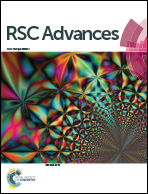A novel, label-free fluorescence detection method for the formation of G-quadruplex DNA based on DNA-templated silver nanoclusters†
Abstract
A novel, label-free fluorescence detection method was proposed for the formation of the G-quadruplex DNAs based on placing two DNA-Ag NCs together to light-up fluorescence. Herein, we designed two tailored DNA sequences noted as target DNA (abbreviated as T-DNA) and complementary DNA (abbreviated as C-DNA), respectively. T-DNA contains two cytosine-rich sequences at the 3′- and 5′-end responsible for Ag NCs synthesis, together with the guanine-rich (G-rich) DNA sequence in the middle segment. C-DNA was designed completely complementary to the G-rich segment of the T-DNA. Provided that the middle G-rich oligonucleotide of T-DNA folds into G-quadruplex in the presence of monovalent cations, the located at 3′ and 5′ terminuses two darkish DNA-Ag NCs approximate, leading to the enhanced fluorescence signal readout. Upon addition of the C-DNA, the G-quadruplex structure is unfolded and the two DNA-Ag NCs are separated, then the fluorescence signal is quenched. On the contrary, when the G-rich oligonucleotide with mutational bases failed to form the G-quadruplex, the fluorescence signal decreased clearly. This design allowed specific and general detection of the formation of diverse G-quadruplexes with easy operation and low cost. We believed that the proposed approach laid a foundation for the researchers in bioimaging, pharmacology, diagnostics, and other fields.



 Please wait while we load your content...
Please wait while we load your content...